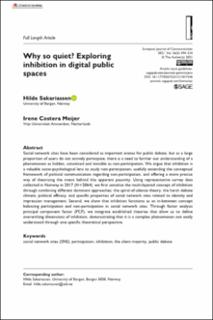| dc.contributor.author | Sakariassen, Hilde | |
| dc.contributor.author | Meijer, Irene Costera | |
| dc.date.accessioned | 2022-01-21T07:14:16Z | |
| dc.date.available | 2022-01-21T07:14:16Z | |
| dc.date.created | 2021-11-26T12:50:59Z | |
| dc.date.issued | 2021 | |
| dc.identifier.issn | 1899-5101 | |
| dc.identifier.uri | https://hdl.handle.net/11250/2838571 | |
| dc.description.abstract | Social network sites have been considered as important arenas for public debate, but as a large proportion of users do not actively participate, there is a need to further our understanding of a phenomenon as hidden, unnoticed and invisible as non-participation. We argue that inhibition is a valuable socio-psychological lens to study non-participation, usefully extending the conceptual framework of political communication regarding non-participation, and offering a more precise way of theorising the intent behind this apparent passivity. Using representative survey data collected in Norway in 2017 (N = 2064), we first sensitise the multi-layered concept of inhibition through combining different dominant approaches: the spiral-of-silence theory, the harsh debate climate, political efficacy, and specific properties of social network sites related to identity and impression management. Second, we show that inhibition functions as an in-between concept balancing participation and non-participation in social network sites. Through factor analysis principal component factor (PCF), we integrate established theories that allow us to define overarching dimensions of inhibition, demonstrating that it is a complex phenomenon not easily understood through one specific theoretical perspective. | en_US |
| dc.language.iso | eng | en_US |
| dc.publisher | Sage | en_US |
| dc.rights | Navngivelse 4.0 Internasjonal | * |
| dc.rights.uri | http://creativecommons.org/licenses/by/4.0/deed.no | * |
| dc.title | Why so quiet? Exploring inhibition in digital public spaces | en_US |
| dc.type | Journal article | en_US |
| dc.type | Peer reviewed | en_US |
| dc.description.version | publishedVersion | en_US |
| dc.rights.holder | Copyright 2021 The Author(s) | en_US |
| cristin.ispublished | true | |
| cristin.fulltext | original | |
| cristin.qualitycode | 1 | |
| dc.identifier.doi | 10.1177/02673231211017346 | |
| dc.identifier.cristin | 1959734 | |
| dc.source.journal | Central European Journal of Communication | en_US |
| dc.source.pagenumber | 494-510 | en_US |
| dc.identifier.citation | Central European Journal of Communication. 2021, 36 (5), 494-510 | en_US |
| dc.source.volume | 36 | en_US |
| dc.source.issue | 5 | en_US |

